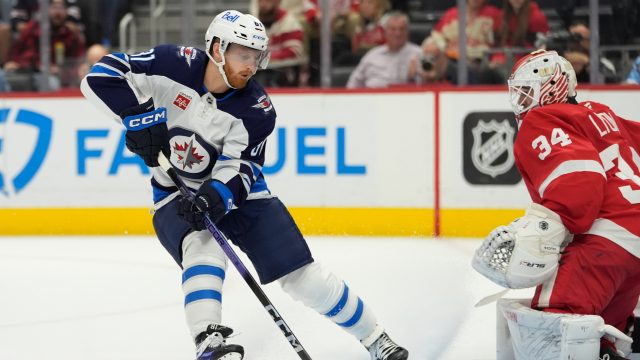OTTAWA — Eleven games into the season is about the point where we don’t know everything, but we think we know the tenor of a hockey team.
Unlike recent starts to the season, the Ottawa Senators are over .500 into November with a 6-5-0 record after Saturday’s victory over the Seattle Kraken, and there is promise of continued improvement.
“Knock on wood. I like a lot of things that we’ve done,” said Ottawa coach Travis Green on his team’s performance thus far.
Time to re-assess and re-evaluate the Senators.
The good, the bad and the hope.
Coaching bump has shown improvements but room to grow
By early November in the last few seasons, some Senators fans had already started to chant “Fire D.J.”—meaning D.J. Smith, who had coached the team since 2019, usually to slow starts.
The question this season is whether Green can elevate a team whose core has remained basically intact.
The most noticeable change in Green’s tenure so far has been mental rather than structural. He calls out his players, stressing the word “accountability” —a far cry from D.J. Smith’s mantra of “bad bounces.”
“For me, if you play good, you play,” said Green. “Coaches want to get the guys on the ice that are playing pretty good. The ones that aren’t, not quite as much.”
He has backed up his words. After franchise goaltender Linus Ullmark had a poor showing against the Vegas Golden Knights in his return from a strain injury, Green started back-up netminder Anton Forsberg against the Colorado Avalanche.
Green’s emphasis has been on the defensive side of the puck. The Senators’ structure has looked more formidable, pressuring opponents to the outside.
It’s worked early on.
According to Natural Stat Trick, the Senators are seventh in expected-goals allowed and sixth in high-danger chances allowed. The Senators’ ability to limit opponents’ high-end opportunities has translated into results, as they have only allowed three goals in their last three games. For a team that was fifth last in goals allowed last season to be sitting in ninth place to begin this season is cause for optimism.
A part of Green’s defence-first attitude has been pushing his best players to flourish on the defensive side of the ice, led by Brady Tkachuk. His defensive acumen was noticed by his co-star, Tim Stützle, who shouted out his captain for clearing the puck repeatedly late in the game against the Seattle Kraken on Saturday when the Sens successfully sat on their two-goal lead.
“I think the old me would have maybe gone for the empty netter but I guess it’s just showing that there’s a new mentality in this room,” said Tkachuk.
One knock against Green so far might be the penalty kill. His new diamond penalty-kill formation has not been hot, at 77 per cent ranked 19th in the league.
Lethal Power Play
A heater (apologies Dany Heatley) is the current state of the Senators’ power play, scoring 12 goals in their first 36 opportunities and power-play goals in five of their six wins.
Green has promoted the Sens’ flashy young defenceman Jake Sanderson to the first unit while shifting Drake Batherson to the bumper and Tkachuk to the slot. The tweaks were designed by someone who knows a thing or two about scoring on the power play: assistant coach Daniel Alfredsson, the franchise leader in power-play points. The reshaping of the power-play unit under Green and Alfredsson has turned the 23rd-ranked power play last season into the third-best in the NHL.
“It’s whenever we get in the zone, we just kind of play hockey, and (we’re) not looking to set up where we have a mindset that we want to score,” said Tkachuk.
There is still room for improvement, though, he says.
“I feel like break-ins can always be a little bit smoother.”
Scoring juggernaut
The improvement in defensive play has yielded results in terms of offence, scoring at the seventh-highest clip in the league to begin the season. The star duo of Tkachuk and Stützle have combined for 31 points in 11 games. Their production has allowed Green to move the veteran Claude Giroux to the second line, where his presence has given life to the previously labouring duo of Batherson and Josh Norris, combining for 22 points in seven outings together.
It hasn’t just been lucky finishing, as the team has the 19st-best shooting percentage at five-on-five. Despite the poor shooting percentage they are outshooting opponents at five-on-five 527 to 507 according to Natural Stat Trick. So, there is progress but also room for improvement.
Meanwhile, the fourth line has been scoring like gangbusters, led by right-winger Adam Gaudette, who is, stunningly, second on the team in goals with six.
“It’s not the norm,” said Green on his fourth-line surge.
“We’re clicking on all cylinders out there, not just in the offensive zone, but neutral zone, defensive zone,” said Gaudette about his line, which also includes Zack MacEwen and Nick Cousins. The trio have outshot opponents 46-36 while scoring nine goals in 11 games, which is closing in on the total of 15 goals from the fourth line all last season.
The defence is falling into place:
The back end has been an area of concern since the team’s last playoff run in 2017. But no more. The Senators have been able to throw out three good pairings every night. It starts with Sanderson, who is the Senators’ first clear-cut No. 1 defenceman since the departure of Erik Karlsson. He’s averaged the most amount of ice-time of any Senators defenceman, while also being a main catalyst on an elite power play, earning seven points on the man-advantage in 11 games.
“I know my importance on the team. I feel like I’m just maturing, and I feel like I’m an impactful player every time I’m on the ice,” said Sanderson.
Sanderson’s promotion has allowed Green to slot Thomas Chabot into a more appropriate position as an elite second-pairing defenceman. “We’re asking Chabot to maybe play a little bit different than he has in the past,” said Green. “And I think his game is improving as I think he is feeling more comfortable in the new system, too.”
Chabot is no longer running the first power-play unit but is now killing penalties.
“We’ve always had a system, but I think in this system it’s black or white, I like to call it,” Chabot told Sportsnet.ca. “There’s no grey area. And I think that’s good for our group. I think that’s where we might have gotten mixed up over the past few years, and kind of being like, where am I supposed to be? What am I supposed to do?”
When Chabot has been paired with Nick Jensen, the Senators have outshot opponents 157-142 at five-on-five. Additionally, Chabot has not been scored on as a penalty killer this season, but he was on the ice for the only Senators short-handed goal.
Not too Shabby.
Then there’s the third pairing. At the beginning of the season there were question marks about whether Tyler Kleven and Jacob Bernard-Docker were full-time NHLers. But with Artem Zub’s injury, the University of North Dakota alumni were reconnected. They’ve thrived.
|
Pairing |
CF% (outshooting opponents) |
xGF% (expected goals share) |
Goals For/Against |
|
Kleven-Bernard-Docker |
55.4% or 97 to 78 |
58.8% |
5-2 |
When Zub returns, as he is expected to do soon, Green says he plans to pair him with Sanderson. He will likely keep Kleven and Bernard-Docker together while dropping Hamonic from the lineup.
Inability to earn points on the road against top teams
Despite their decent record so far, the Senators have summoned up some ghosts from seasons past.
Last season, the Senators squandered a tie or lead in the third period to lose 12 times, which was eighth-worst in the NHL. This season, they’ve already done it again: on the road against Vegas up 5-4 with three minutes left, and in a tie game in Colorado with nine minutes left.
In the previous two seasons, the Senators were 45-32-3 at home and 32-44-3 on the road. That translates into a 93-point pace in home games — which would place them close to a playoff spot — while they had a 65-point pace on the road. This season, it’s been the same story on the road, with a 1-4-0 record.
If the Senators are serious about the playoffs, they’ll need to learn how to become road warriors.
Good goaltending in Ottawa?
Lousy goaltending has been the kryptonite for this team in previous iterations. This season the goaltending was weak to start but has improved lately. Since his return from injury, Ullmark has saved 44 of his last 47 shots. Meanwhile, Forsberg, who had a rough start to the season, giving up three goals on his first nine shots, now has two shutouts in his last three games while saving 135 of 146 shots for a .924 per cent save percentage.
Through 11 games, the Senators’ save percentage is 13th-best in the league. The goaltenders may not be stealing games, but most nights, they are giving the team a chance to win.
Good enough has got the team to where it is. Better goaltending might take it to where it wants to be.





No comments:
Post a Comment